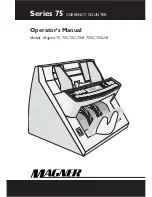
2
6.
CERTIFICATIONS AND COMPLIANCES:
SAFETY
IEC 61010-1, EN 61010-1: Safety requirements for electrical equipment
for measurement, control, and laboratory use, Part 1.
IP65 Enclosure rating (Face only), IEC 529
Type 4X Enclosure rating (Face only), UL50
ELECTROMAGNETIC COMPATIBILITY
Notes:
1. Burst to DC backlight power had a power line filter installed RLC
#LFIL0000 or equivalent at the unit.
2. Self-recoverable loss of performance during EMI disturbance at 10
V/rms to backlight power lines.
LCD segments may flicker during EMI disturbance.
For operation without loss of performance:
Install power line filter RLC #LFIL0000 or equivalent at the unit.
Refer to the EMC Installation Guidelines section of this bulletin for
additional information.
7.
ENVIRONMENTAL CONDITIONS:
Operating Temperature Range
: 0 to 50°C Derate max. operating
temperature to 40°C above 26 VDC. (Backlight versions)
Storage Temperature Range
: -30 to 80°C
Operating and Storage Humidity
: 85% max. (non-condensing) from 0°C to
50°C.
Altitude
: Up to 2000 meters
8.
CONSTRUCTION:
High impact plastic case with clear viewing window.
The front panel meets NEMA 4X/IP65 requirements for indoor use when
properly installed. Installation Category I, Pollution Degree 2. Panel gasket
and mounting clip included.
9.
WEIGHT:
2 oz. (57 grams) [with battery]
EMC INSTALLATION GUIDELINES
Although this unit is designed with a high degree of immunity to
ElectroMagnetic Interference (EMI), proper installation and wiring methods
must be followed to ensure compatibility in each application. The type of the
electrical noise, source or coupling method into the unit may be different for
various installations. In extremely high EMI environments, additional measures
may be needed. The unit becomes more immune to EMI with fewer I/O
connections. Cable length, routing and shield termination are very important
and can mean the difference between a successful installation or a troublesome
installation. Listed below are some EMC guidelines for successful installation
in an industrial environment.
1. Use shielded (screened) cables for all Signal and Control inputs. The shield
(screen) pigtail connection should be made as short as possible. The
connection point for the shield depends somewhat upon the application.
Listed below are the recommended methods of connecting the shield, in order
of their effectiveness.
a. Connect the shield only at the panel where the unit is mounted to earth
ground (protective earth).
b. Connect the shield to earth ground at both ends of the cable, usually when
the noise source frequency is above 1 MHz.
c. Connect the shield to common of the unit and leave the other end of the
shield unconnected and insulated from earth ground.
2. Never run Signal or Control cables in the same conduit or raceway with AC
power lines, conductors feeding motors, solenoids, SCR controls, and
heaters, etc. The cables should be run in metal conduit that is properly
grounded. This is especially useful in applications where cable runs are long
and portable two-way radios are used in close proximity or if the installation
is near a commercial radio transmitter.
3. Signal or Control cables within an enclosure should be routed as far away as
possible from contactors, control relays, transformers, and other noisy
components.
4. In extremely high EMI environments, the use of external EMI suppression
devices, such as ferrite suppression cores, is effective. Install them on Signal
and Control cables as close to the unit as possible. Loop the cable through the
core several times or use multiple cores on each cable for additional protection.
Install line filters on the power input cable to the unit to suppress power line
interference. Install them near the power entry point of the enclosure. The
following EMI suppression devices (or equivalent) are recommended:
Ferrite Suppression Cores for signal and control cables:
Fair-Rite # 0443167251 (RLC #FCOR0000)
TDK # ZCAT3035-1330A
Steward #28B2029-0A0
Line Filters for input power cables:
Schaffner # FN610-1/07 (RLC #LFIL0000)
Schaffner # FN670-1.8/07
Corcom #1VR3
Note: Reference manufacturer’s instructions when installing a line filter.
5. Long cable runs are more susceptible to EMI pickup than short cable runs.
Therefore, keep cable runs as short as possible.
WIRING CONNECTIONS
The electrical connections are made via screw-clamp terminals located on the
back of the unit. All conductors should meet voltage and current ratings for each
terminal. Also cabling should conform to appropriate standards of good
installation, local codes and regulations. It is recommended that power supplied
to the unit (AC or DC) be protected by a fuse or circuit breaker. When wiring
the unit, use the battery cover to identify the wire position with the proper
function. Strip the wire, leaving approximately 1/4" bare wire exposed (stranded
wires should be tinned with solder). Insert the wire under the screw-clamp and
tighten down the screw until the wire is clamped in tightly. Each terminal can
accept up to two #14 AWG wires.
WARNING:
Lithium battery may explode if incinerated. All leads
will be at the same line potential as the input leads.
EN 61000-4-2
Enclosure class B
Power mains class B
EN 55022
RF interference
Emissions to EN 50081-1
150 KHz - 80 MHz
Level 3; 10 V/rms
2
EN 61000-4-6
RF conducted interference
Level 3; 2 Kv power
Level 4; 2 Kv I/O
1
EN 61000-4-4
Fast transients (burst)
80 MHz - 1 GHz
Level 3; 10 V/m
EN 61000-4-3
Electromagnetic RF fields
Level 3; 8 Kv air
Level 2; 4 Kv contact
Electrostatic discharge
Level 4; 30 A/m
Level 3; 10 V/m
EN 61000-4-8
ENV 50204
Power frequency magnetic fields
Simulation of cordless telephone
200 Hz, 50% duty cycle
Immunity to EN 50082-2
900 MHz
±
5 MHz
TROUBLESHOOTING
For further technical assistance, contact technical support at the appropriate
company numbers listed.
Содержание CUB 1
Страница 30: ...7 This page intentionally left blank...
Страница 46: ...5...
Страница 47: ...6...
Страница 48: ...7...
















































